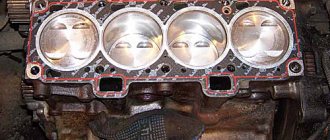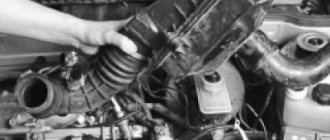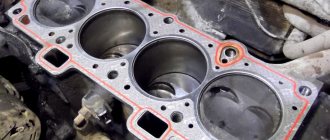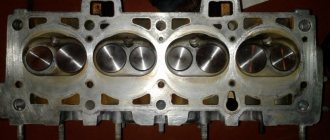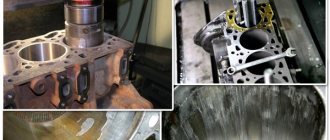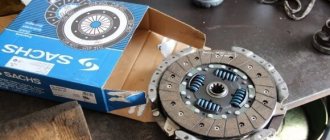Purpose of the cylinder head
In internal combustion engines, the cylinder head (cylinder head), (often called simply the head) is installed and secured to the cylinder block.
The cylinder head seals the cylinders, creating closed combustion chambers. A cylinder head gasket is installed between the cylinder head and the cylinder blocks. The design of the cylinder head can be different and vary significantly depending on the type of engine. Valves with springs, spark plugs and injectors are mounted in the block head.
Head gasket - where is it installed, what role does it play and how does it work?
Where is the heroine of our article installed in the engine? As the name suggests - under the engine head. Exactly - between the head and the cylinder block.
What is the purpose of using a cylinder head gasket? For gasoline and diesel engines, sealing is extremely important. This is one of the key parameters that ensures the correct operation of the power unit, as well as all systems that ensure its operation - cooling systems, fuel supply, lubrication and exhaust. This is even more important because all major systems operate under high pressure. The head gasket seals the combustion chamber, protects against exhaust leaks, and seals the engine against leaks and mixing of coolant and engine oil.
What does an engine head gasket look like? It is flat, has a rubber gasket at its ends, and a whole series of holes in the gasket itself. The biggest thing is the sealing of individual cylinders. The smaller ones are the coolant ports, engine oil passages, and mounting screw holes.
The head gasket must be flexible enough to perfectly align the top surface of the housing and the bottom surface of the head at the same time, regardless of the prevailing conditions.
And the gasket requires no maintenance. Of course, until it breaks. But after replacement, it again does not require maintenance.
But that is not all. The gasket should be pressed against the top of the block and the bottom of the head, but should not stick to them. This, in turn, makes it easier to assemble and disassemble the engine head.
Every minute the engine runs, it is exposed to aggressive chemicals from fuel, coolant and oil, exhaust gases at strong, constantly changing pressure (up to 190 bar) and at high temperatures, also varying up to 3000 degrees Celsius. this is further emphasized by the cast iron motor housings and their metal (often aluminum) heads and steel bolts connecting the housing to the head. So, how can we assume that such a gasket can work throughout the entire technical life of the engine? Well, in many cases it is possible. Firstly, thanks to the use of appropriate materials (when the car manufacturer orders good parts for the first assembly), and secondly, thanks to the correct operation of the car engine, without unnecessary overload. And the engine itself must also be free of defects.
What are modern gaskets made of? Is it the same as other seals, such as those under the valve cover, but made of rubber? No. No rubber can withstand such conditions. Let's look at the most commonly used solution, that is, a metal head gasket and composition. The substrate material is a thin steel sheet with a diameter of 0.3 millimeters. The sheet metal is covered with composite material on the bottom and top. In turn, it has a plastic layer on it. Its task is to ensure better adhesion of the gasket to the surface of the cylinder head and cylinder block and eliminate irregularities. The holes in individual cylinders are sealed with steel and aluminum tape.
In addition, the engine oil and coolant flow passages are closed. An elastomeric material is used here.
Cylinder head material
On passenger cars, the engine block head is usually made of aluminum alloy by die casting or injection molding.
On heavy (diesel) engines, a block head made of cast iron is used. In such engines, the valve seats are cooled and then pressed into place. The cylinder head has channels for gases, coolant, oil, and bolt holes for attaching the head to the cylinder block.
To fasten the head to the cylinder block, power bolts and studs with nuts are used. The head gasket serves as a seal. The cylinder head bolts are tightened in a specific sequence in the order recommended by the manufacturer.
Modern cylinder head gaskets.
The cylinder head gasket is used in the repair of not only domestic cars, but also foreign ones. It serves to eliminate all possible oil leaks when supplied to the engine and to seal the combustion chamber. The cylinder head gasket also affects the elastic deformation of parts.
Typically, cylinder head gaskets are made from multilayer plastic (combined) or metal compounds. Often the cause of engine problems is found in the cylinder head gasket. For example, if the engine overheats, if there is an oil or water leak, etc. Professionals know that high-quality cylinder head gasket cannot be done in “makeshift” conditions. The cylinder head is one of the most important elements of the engine, so breakdowns and defects of the cylinder head should be taken seriously.
Problems may arise when it is necessary to replace the cylinder head gasket of some foreign cars. It must be remembered that poor-quality replacement or repair of the cylinder head can lead to serious problems - increased fuel consumption, reduced engine life and a decrease in engine power as a whole.
Overhead valve cylinder head
It can be made individually for each cylinder, or for a number of cylinders. The valves are driven by rods that transmit force from the camshaft.
Overhead valve heads have several layout options:
– Valve drive from rods;
– Overhead camshaft (OHC);
– Double overhead camshafts (DOHC).
Customized cylinder heads
The advantage of individual cylinder heads is the lighter head weight and ease of installation. Most often, individual heads are used on diesel and large-sized engines, which greatly simplifies installation.
Cylinder head malfunctions:
- gas breakthrough, causes: curvature of the gas joint, corrosion, damage to fasteners;
- crack, loss of seat;
- wear of the fit under the camshaft or pushers;
- wear of valve guides;
- broken fasteners, broken spark plug threads or bolts, cracks.
Malfunctions of the cylinder head also include breakdowns or wear of such cylinder head parts as: valves, springs, rockers, compensators.
Broken threads for the spark plug are eliminated by installing a screwdriver; the torn fasteners are replaced with repair studs.
Defects in the cylinder head include cracks. A crack in the cylinder head, as a rule, leads to the breakthrough of gases into the cooling jacket and engine failure (in this case, repairing the cylinder head is not advisable). Most often, a crack in the cylinder block is an indication for replacing the part. Cracks outside the gas joint can be welded.
What are cylinder head gaskets?
The cylinder head (cylinder head) is one of the main components of the above-piston cavity, where all the thermal processes of the working cycle take place.
Engine performance depends on the quality of the cylinder head gasket and its installation. Defects and incorrect installation may result in engine failure. Therefore, replacing the cylinder head gasket should be approached very seriously and carefully, choosing only high-quality gaskets. The gasket itself is a high-tech and complex part made of several layers with a frame made of perforated thin-sheet steel. Its main purpose is to seal the joints of the cylinder head with the engine cylinder block.
]cylinder head gaskets[/anchor] must be tested for their tightness, corrosion resistance, etc. This should ensure full compliance of the gasket with the technical and design conditions for 100% sealing of the engine. cylinder head gaskets is relevant , since it is in them that the load on the head gasket is very high, because the pressure in the engine itself is very high. All this leads to damage to the gasket.
The most important characteristic of a cylinder head gasket is its high temperature resistance, which guarantees its long service life. For an accurate sealed connection between the cylinder head and the block itself, precise stamping and special processing of the gaskets are required. Manufacturers sometimes screen-print silicone onto the surface of the gaskets for a better seal.
Industrial materials
offers you to buy cushioning materials at a very competitive price! In our catalogs you can find high-quality products made from rubber, asbestos, cardboard and polymers. We work throughout the country and deliver orders to any city in Russia through transport companies. You can quickly and profitably purchase gasket material for engines, flange connections and other components from us!
Cardboard spacer GOST 9347-74
You might be interested in
Gasket and sealing materials
Gaskets are a general name for a wide group of different products used as sealing and sealing elements. Such products are actively used in almost all sectors of industrial production, as well as pharmaceutical, construction, repair and utility sectors.
Gasketing and padding materials are widely used in everyday life: these include rubber edging on doors and windows, all kinds of O-rings and gaskets in plumbing and pipelines, oil seals and hydraulic cuffs in various components of cars, as well as cardboard packaging for items and baked goods.
Gasketing and sealing materials can be divided into several groups, based on the physical properties and chemical composition of these categories. In particular, we can highlight the most popular and popular groups of materials, which are widely represented in our catalogs and are familiar to a large number of customers:
- Rubber products (rings; cuffs; wipers; gaskets)
- Asbestos products (paronite PON, PMB, PE, PA; brake band)
- Cardboard and paper (packaging and cushioning)
- Rubber-fabric products (technical plates, conveyor belts, sleeves)
- Synthetic products (caprolon, fluoroplastic, polyethylene)
The main requirements for sheet gasket material include resistance to various temperatures and climatic conditions, flexibility and elasticity, the ability to withstand high pressure and physical stress, as well as resistance to many aggressive chemical environments.
The choice of cushioning material should be made based on the working environment conditions and the direct purpose of a particular product. In addition, it is important to consider the size and shape of the sealed joint. All products presented in the catalogs of our website have a wide variety of species. See, choose and order!
Types of gaskets used in the carburetor
The following types of gaskets are used in the carburetor:
- Gasket between carburetor and intake manifold. In most engine models, this part is made of paronite. This part is installed directly on the collector plane;
- Thermal insulation gasket. This part is also installed under the carburetor. The thermal insulation gasket is usually made of textolite, so it copes with its function perfectly;
- Lower carburetor gasket. This part is installed between the heat-insulating gasket and the carburetor flange. The lower carburetor gasket is made of metal-textolite material. This gasket perfectly prevents the formation of leaky areas in the lower part of the carburetor mount;
- Upper gasket. This part is installed between the carburetor and the air filter pipe. It is made of dense rubber, therefore it provides a tight connection, preventing the leakage of untreated air;
- Carburetor cover gasket. It is made of thick cardboard and serves to reliably seal the two halves of a Solex carburetor. The Solex carburetor gasket most often causes carburetor malfunction, but this problem can be easily solved if the old gasket is replaced with a new one.
Replacing the cardboard spacer
Installing a cardboard gasket will not take much time, but when carrying out this operation, care and caution are required so as not to damage the fragile internal parts of the carburetor, as well as to eliminate the possibility of dust and dirt getting inside the float chamber.
Carburetor gasket sets can be purchased at an auto parts store or ordered online. In the latter case, you definitely won’t have to stand in line.
For Solex carburetors you can find cardboard gaskets sold separately. In this case, the cost of repairs will be almost invisible to the budget.
After the carburetor is removed, the five bolts that secure the cover are unscrewed. The cover is then removed and the float is removed, which is held in place by a pin.
The pin should be carefully knocked out of the hole using a thin nail and a hammer.
When the pin is removed, the float is disconnected from the needle and completely removed. The old gasket can now be easily removed from the top cover of the carburetor, and a new cardboard piece installed in its place.
Then we assemble the carburetor and install it in the reverse order of removal.
Tightening the carburetor bolts that hold the top cover must be done evenly and crosswise to prevent misalignment and the possible leakage of air into the carburetor mixing chamber in this case.
What to make gaskets for a car engine from
Today I want to talk about how I make pads.
On the Internet I found a description of what people make gaskets from. I used to make them from paronite. But I don't like the material itself. The oil makes paronitis soft like snot. The connections need to be constantly pulled, it gets wet and looks extremely sloppy.
Paper is the best choice. And because I work in the printing industry - I could have chosen the paper for the gaskets more consciously. I’ll say right away that I don’t like coated paper (from magazine covers as advised on the Internet), although I had a huge selection of it. I think its main disadvantage is that it practically consists of only chalk (and now there is just a wave of low-quality paper from China). Whatever one may say, chalk is an abrasive. Although very weak. Nobody wants to have abrasive in their engine. A more or less suitable paper is chrome ersatz (as on doctors’ magazines, medical records). But still, there is also chalk on this paper.
I had a criterion - no chalk. And it seems that such paper simply does not exist for printing! But it exists in a different form. So - I found her. Write down the name - calibrated cardboard (I had PAVAN) 0.5 mm, color - gray. Refers to under-deck materials (placed under offset rubber). You can find them in companies selling printing supplies. And also in printing houses with offset machines. This cardboard is replaced by printers and simply disposed of after some time. If you have friends, go and ask.
The main advantage of this cardboard is that it is really tough. There is no chalk in it. And it is very accurate (the difference in thickness is no more than 0.01mm).
My method is not fast, but it is as accurate as possible for home use.
We take the sealant and apply a thin layer to the surface. I just take the sealant on my finger and tap it lightly (I apply thermal paste to the processor in much the same way). Next, I place the sheet on a flat surface and press the lid against the paper with something heavy.
In my case, I pulled the lid through the hole in the center using a pin.
Then I wait about a day (that’s why this method is not fast). I roughly cut around the perimeter with a margin of a couple of centimeters with scissors.
The cardboard has already been properly adhered to the surface using sealant.
We take a stationery knife with this grip and cut off the outer contour.
Next, to find the inner contour, press the contour with your fingers. It was not visible in the photo, but after this the internal contour begins to be clearly visible. We cut the inner contour in the same way
I carefully drilled the holes with a punch I made (it’s still good to have a lathe on hand!)
And the result is quite decent. Next, purging, rinsing with alcohol.
Applying sealant to the mating part (try to use the minimum amount of sealant).
And one more “trick” - pulling with a screwdriver with a torque limit. Gradually adding torque we tighten all the bolts. Leave it for a couple of hours and tighten it with a key (without fanaticism).
This is not the first renovation using this technology. I have used such gaskets several times already and there are no problems with them. They don't get wet or sweat. They hold up great. Knowing this technology, I am not afraid to open the engine even for inspection. Because I know that I can make this gasket myself for free.
I hope this information helps someone and good luck to everyone on the roads!
Source
How to make a gasket yourself
You can make the carburetor gasket yourself. This need arises when it was not possible to find an original spare part. To make the gasket you will need the following tools and materials:
- Thick cardboard;
- Nail scissors;
- Fountain pen refill.
To make the gasket, you can use any thick cardboard. The thickness of the material should be about 0.8 mm. If the thickness is greater, then such cardboard can also be used to make a gasket, but in this case it will be necessary to additionally adjust the position of the carburetor float.
Blitz tips and tricks
- The efficiency of the engine and its dynamic performance depend on how the carburetor gaskets are installed, so if problems arise in the operation of this device, you must immediately begin replacing the gasket;
- It is possible to make yourself not only a product from cardboard, but if you need a homemade textolite gasket, then it is made from a sheet of textolite of suitable thickness. In this case, the material is processed using special scissors;
- If necessary, the rubber gasket for the pipe can be made of dense rubber of suitable thickness. Holes for bolts in the rubber gasket are made using a drill and twist drills, but the gasket must be securely fixed between two wooden boards;
- Before purchasing a gasket in a store, you need to disassemble the carburetor and see what the part costs;
- Thermal insulating gasket can be installed in the amount of 2 pieces, when a suitable thickness of the part cannot be found, or the textolite for self-production is not suitable for this parameter. Thermal insulation, in this case, is not compromised, and the unit can be used under normal load conditions.
Replacing the carburetor gasket or making it from cardboard will not be difficult, but you should be very careful about the selection of material, as well as the accuracy of manufacturing this part. After replacing the product, the carburetor is installed on the engine and the engine is test run, as a result of which it will be clear how correctly all repair operations were performed.
What is the cylinder head gasket made of?
If other components of the machine use gaskets made of special cardboard or rubber, then for the head a product made of special materials and having a complex shape is used. The material must be sufficiently durable and heat-resistant. Today, all sealing gaskets can be divided into a couple of large groups.
- Non-metallic. There are two types: asbestos and non-asbestos. In the first case, the gasket is made of sheet material. In this case, all holes (for cylinders and fasteners) along the edge of the cutout are reinforced with metal rings. They also produce gaskets made from pressed rubber with the addition of graphite powder and asbestos fibers. You can do without the latter: in this case, synthetics and rubber, pressed at high temperatures, are used. Such gaskets are somewhat more expensive than those discussed above, but they have increased wear resistance.
- Metal. Considered the most common. The material for their manufacture is sheet copper (an expensive option) or thin sheet steel. To achieve better compaction, areas in contact with the planes of the cylinder head and cylinder block are coated with a special rubber compound. Metal gaskets have a longer service life compared to asbestos gaskets. However, defects may occur in both types of products.
